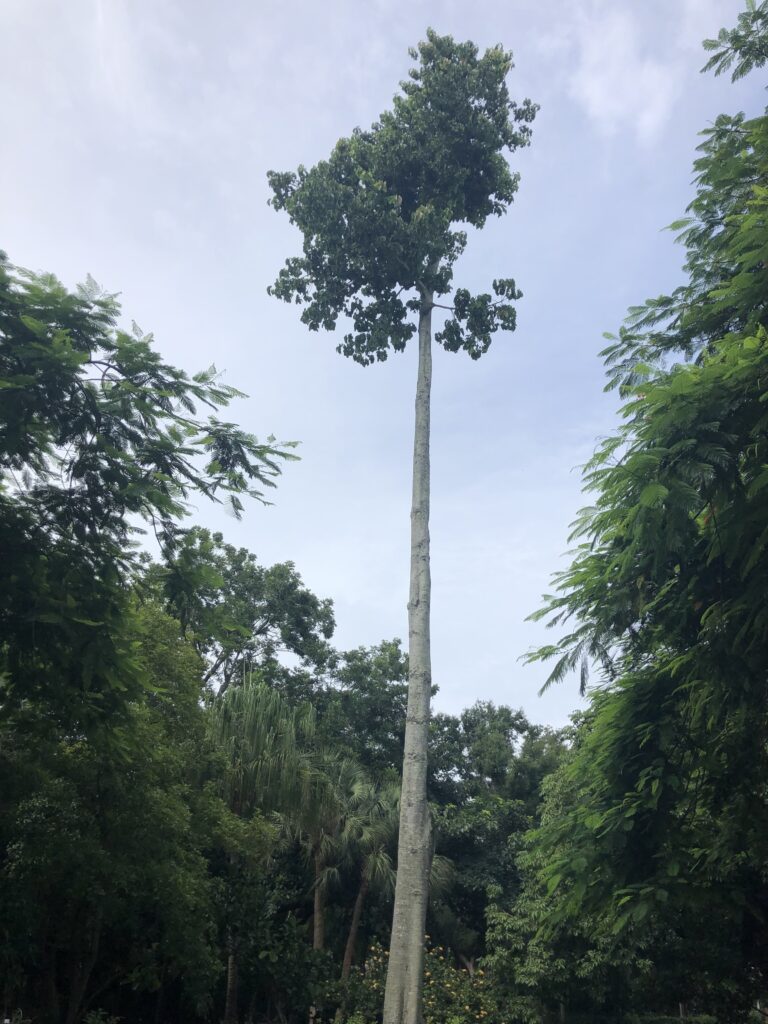June 30, 2020
Trees Reach Champion Size at Edison and Ford Winter Estates
FORT MYERS, Fla. (June 30, 2020) – Edison and Ford Winter Estates has five trees on the official Florida Champion Tree Register. The American Forests organization created the champion tree program in 1940 to recognize the largest known tree of each species in the United States. In 1975, Florida began keeping a state register and recognizes the largest trees within the state.

The Buddha Coconut (Pterygota alata) in the research gardens at Edison and Ford Winter Estates stands 85′ tall and is one of the tallest trees on the property.
For a tree to qualify, a forester from the Florida Division of Forestry measures and scores it for program consideration. Scores are based on tree height, trunk circumference measured at about four and half feet from the ground, and crown canopy. The champion isn’t always the tallest tree. For example, the champion Buddha Coconut tree (Pterygota alata) in the Edison Ford research gardens is one of the tallest trees on the property, measuring 85′ tall, but it is actually eight feet shorter than the other Buddha Coconut on the grounds. The champion has a larger circumference (112”) and larger crown canopy, giving it a few more total points.
There are four other champions around the site: the King or Alexander Palm (Archontophoenix alexandrae) is located near the Moonlight Garden and stands at 66’ tall and 40” in circumference; the Blue Mahoe (Talipariti elatum) is 59’ tall and 133” in circumference and is growing near the pier; the Indian Coral Tree (Erythrina variegata) is 35’ tall and 114” in circumference and is located near the Edison guest house; and the Puerto Rican Hat Palm (Sabal causiarum) is 45’ tall and 89” in circumference, and stands near the Edison caretaker’s house.
Other notable trees, include the Ditabark (Alstonia scholaris), located at the far end of the first parking lot off McGregor Boulevard. It is a Florida Challenger at 69’ tall and 130” in circumference. It’s a big tree, but there are two co-champions in Miami-Dade County that score higher. The iconic Banyan tree is considered by many to be the largest banyan in the continental United States and was once awarded Florida Champion Tree status. However, to protect historic buildings, the tree has been trimmed. The program currently lacks a standardized method to measure the circumference of trees like the banyan, which prevents it from officially being declared as a champion. Tree experts are trying to establish a standard method for measuring banyans for future comparisons and the Florida Champion Tree program does not currently include banyans on the list of measured species.
There are many other majestic trees on the property, including ones that don’t qualify for Champion status. The Mysore Fig (Ficus drupacea) on the Ford property is grand with a height of about 86′ and a circumference of 305″, but it does not even qualify for challenger status. The site has had six other champions over the years; however, some trees have died and others have been surpassed by trees elsewhere in the state.
Beyond the champion trees, there are hundreds of other plants for visitors to see. The botanical gardens consist of 20 acres with more than 1,900 plants from 750 different species — not counting short-lived plants. There are also 300+ species of ornamentals, 170+ species of non-fruiting trees, 85 species of fruit trees, 14 species of citrus trees (not including the new plantings on the Ford property), 20 species of ficus, 97 species of palms, 17 species of bamboo, 20 species of cycads, 43 types of vines and 35 Staghorn ferns!
Throughout the site, there are several areas of defined specialty gardens, including the Moonlight Garden, filled with white flowers and a reflecting pool; Clara Ford’s Rose Garden; the Succulent Garden, with an Agave plant that was an offspring from Thomas Edison’s plant; a shade garden; a butterfly demonstration garden; and an area dedicated to Florida native plants.
For anyone who has never been to the site, there is a lot more to see beyond the gardens. The site includes the historic winter homes of Thomas Edison and Henry Ford, caretaker’s homes of both inventors, Edison’s study, a 15,000-square-foot Inventions Museum, and the Botanic Research Laboratory — a National Historic Chemical Landmark. Visitors can see hundreds of inventions and artifacts, as well as several antique cars.
The site is open from 9 a.m. to 4:30 p.m., seven days a week. There are several tour options, including self-guided, historian-led guided tours, inside-the-homes, automotive, and garden tours. Due to COVID-19, tour group size is currently limited to 10 people and masks are required for all guided tours. Masks are also required inside the museum and the botanic research laboratory. For everyone’s safety, all staff are wearing masks, sanitizer stations are available throughout the site, and plastic shields have been installed at the ticket counter. Visitors are encouraged to wear masks at all times and practice social distancing. Masks are available for sale in the Museum Store. For tour times, tickets or additional information, visit our home page or call 239-334-7419.
